Reading Development in Young English Learners: A Comprehensive Report
VerifiedAdded on 2023/03/17
|14
|4046
|54
Report
AI Summary
This report delves into the crucial topic of teaching English to young learners, emphasizing the significance of reading development. It begins with an introduction highlighting the importance of English literacy and the need to cultivate reading habits in children from an early age. The report then describes a chosen reading method, the 'balanced approach,' which integrates skill-based and literature-based frameworks. It explains various activities, such as visual images, storytelling, and word usage, designed to engage children and enhance their reading comprehension. The resources used for these activities, including flashcards and comic strips, are also discussed. The report further examines how the balanced approach supports children's literacy and reading development, emphasizing the importance of making reading attractive and providing a conducive environment. The report concludes by summarizing the strengths of the chosen approach and its impact on young learners, providing a detailed overview of effective reading methods and activities for fostering literacy in young English learners.
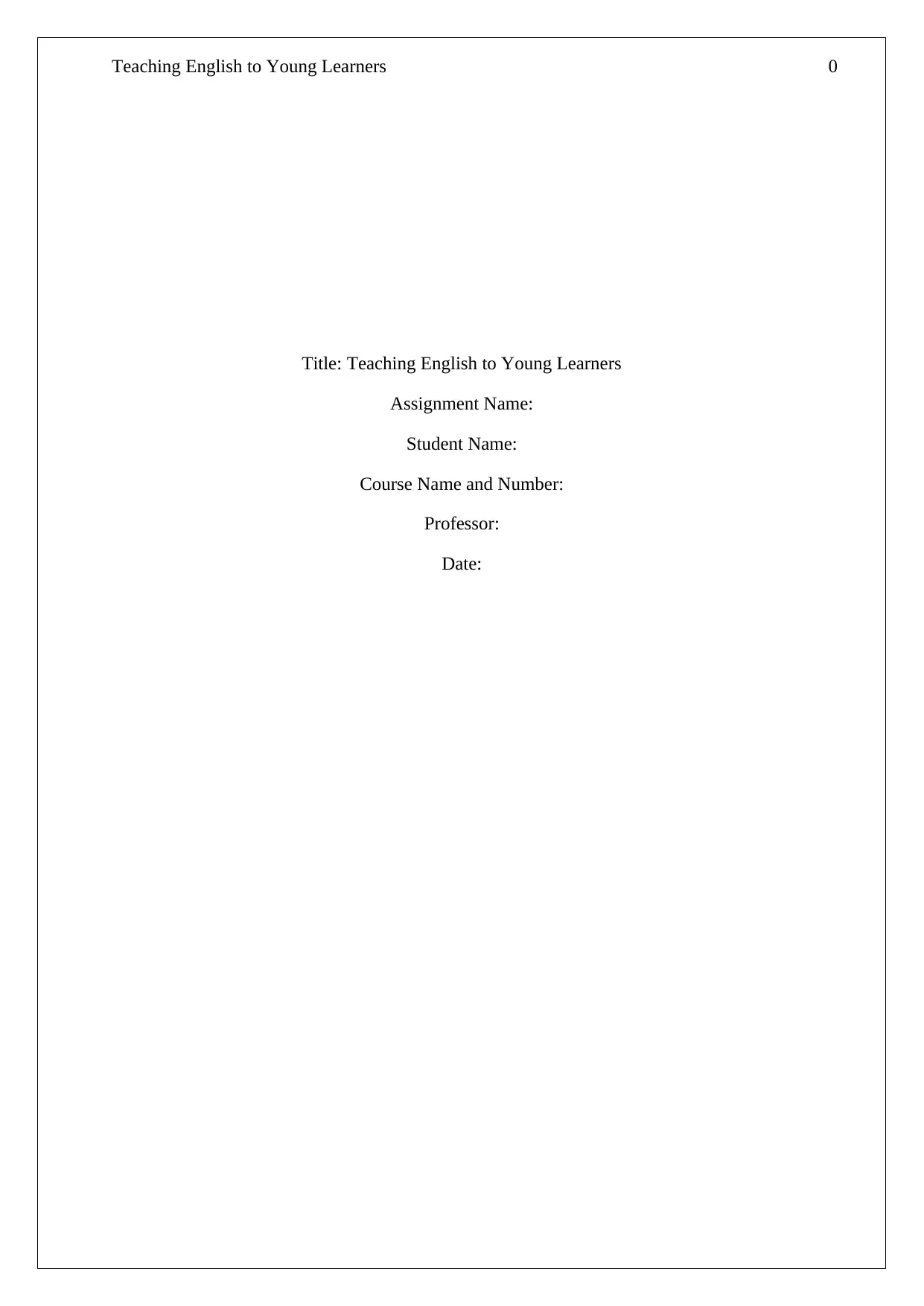
Teaching English to Young Learners 0
Title: Teaching English to Young Learners
Assignment Name:
Student Name:
Course Name and Number:
Professor:
Date:
Title: Teaching English to Young Learners
Assignment Name:
Student Name:
Course Name and Number:
Professor:
Date:
Paraphrase This Document
Need a fresh take? Get an instant paraphrase of this document with our AI Paraphraser
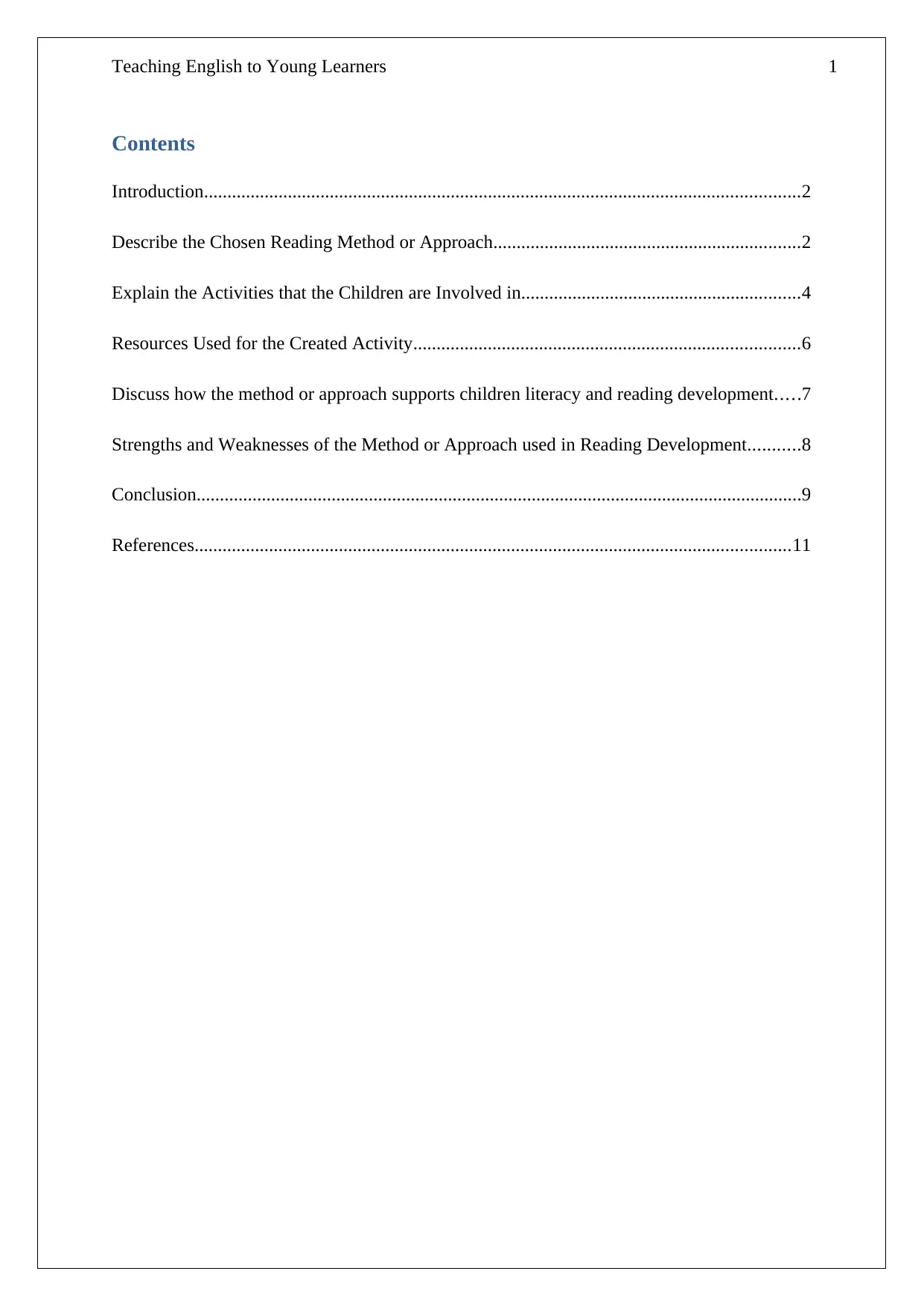
Teaching English to Young Learners 1
Contents
Introduction................................................................................................................................2
Describe the Chosen Reading Method or Approach..................................................................2
Explain the Activities that the Children are Involved in............................................................4
Resources Used for the Created Activity...................................................................................6
Discuss how the method or approach supports children literacy and reading development.....7
Strengths and Weaknesses of the Method or Approach used in Reading Development...........8
Conclusion..................................................................................................................................9
References................................................................................................................................11
Contents
Introduction................................................................................................................................2
Describe the Chosen Reading Method or Approach..................................................................2
Explain the Activities that the Children are Involved in............................................................4
Resources Used for the Created Activity...................................................................................6
Discuss how the method or approach supports children literacy and reading development.....7
Strengths and Weaknesses of the Method or Approach used in Reading Development...........8
Conclusion..................................................................................................................................9
References................................................................................................................................11
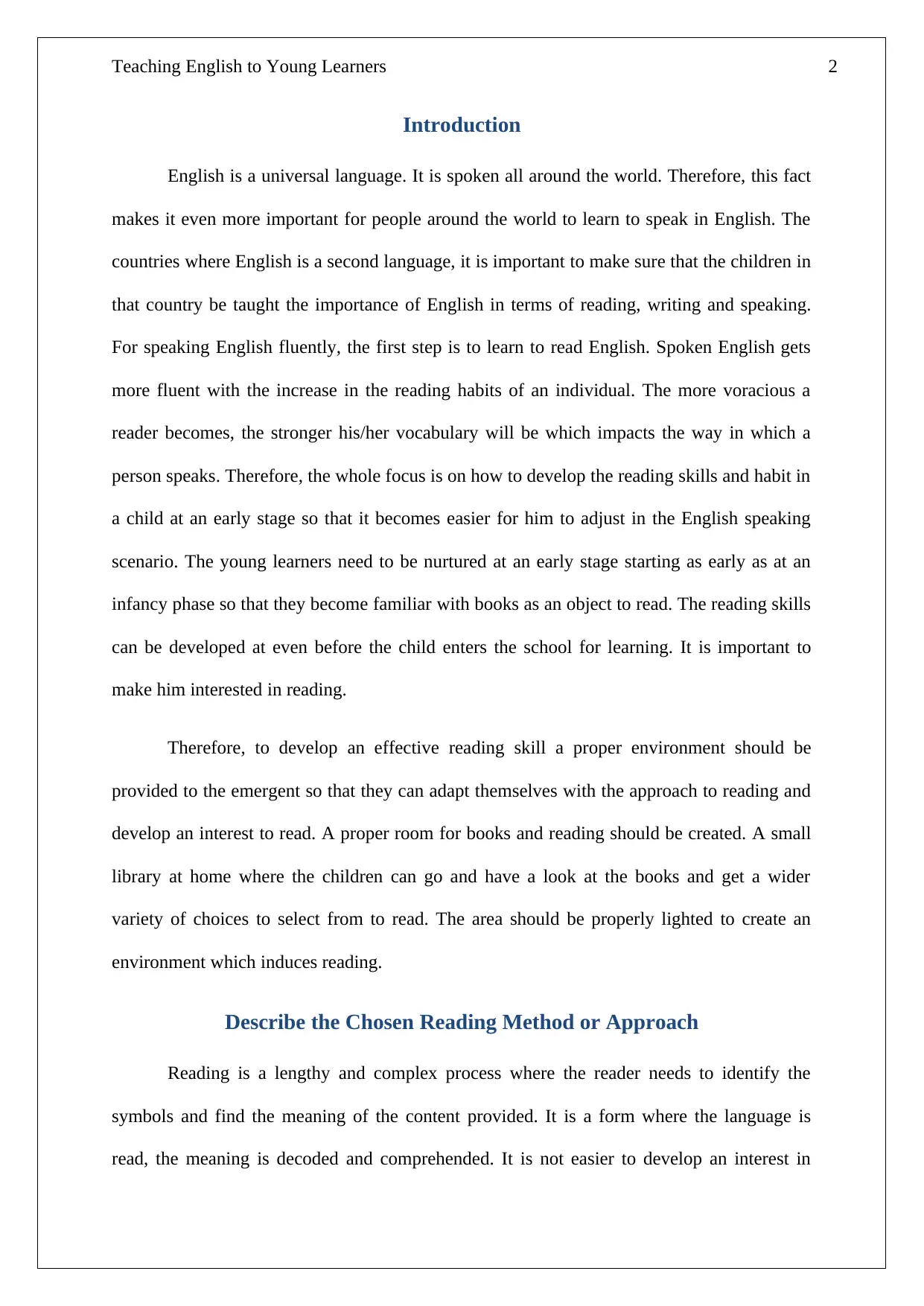
Teaching English to Young Learners 2
Introduction
English is a universal language. It is spoken all around the world. Therefore, this fact
makes it even more important for people around the world to learn to speak in English. The
countries where English is a second language, it is important to make sure that the children in
that country be taught the importance of English in terms of reading, writing and speaking.
For speaking English fluently, the first step is to learn to read English. Spoken English gets
more fluent with the increase in the reading habits of an individual. The more voracious a
reader becomes, the stronger his/her vocabulary will be which impacts the way in which a
person speaks. Therefore, the whole focus is on how to develop the reading skills and habit in
a child at an early stage so that it becomes easier for him to adjust in the English speaking
scenario. The young learners need to be nurtured at an early stage starting as early as at an
infancy phase so that they become familiar with books as an object to read. The reading skills
can be developed at even before the child enters the school for learning. It is important to
make him interested in reading.
Therefore, to develop an effective reading skill a proper environment should be
provided to the emergent so that they can adapt themselves with the approach to reading and
develop an interest to read. A proper room for books and reading should be created. A small
library at home where the children can go and have a look at the books and get a wider
variety of choices to select from to read. The area should be properly lighted to create an
environment which induces reading.
Describe the Chosen Reading Method or Approach
Reading is a lengthy and complex process where the reader needs to identify the
symbols and find the meaning of the content provided. It is a form where the language is
read, the meaning is decoded and comprehended. It is not easier to develop an interest in
Introduction
English is a universal language. It is spoken all around the world. Therefore, this fact
makes it even more important for people around the world to learn to speak in English. The
countries where English is a second language, it is important to make sure that the children in
that country be taught the importance of English in terms of reading, writing and speaking.
For speaking English fluently, the first step is to learn to read English. Spoken English gets
more fluent with the increase in the reading habits of an individual. The more voracious a
reader becomes, the stronger his/her vocabulary will be which impacts the way in which a
person speaks. Therefore, the whole focus is on how to develop the reading skills and habit in
a child at an early stage so that it becomes easier for him to adjust in the English speaking
scenario. The young learners need to be nurtured at an early stage starting as early as at an
infancy phase so that they become familiar with books as an object to read. The reading skills
can be developed at even before the child enters the school for learning. It is important to
make him interested in reading.
Therefore, to develop an effective reading skill a proper environment should be
provided to the emergent so that they can adapt themselves with the approach to reading and
develop an interest to read. A proper room for books and reading should be created. A small
library at home where the children can go and have a look at the books and get a wider
variety of choices to select from to read. The area should be properly lighted to create an
environment which induces reading.
Describe the Chosen Reading Method or Approach
Reading is a lengthy and complex process where the reader needs to identify the
symbols and find the meaning of the content provided. It is a form where the language is
read, the meaning is decoded and comprehended. It is not easier to develop an interest in
⊘ This is a preview!⊘
Do you want full access?
Subscribe today to unlock all pages.

Trusted by 1+ million students worldwide
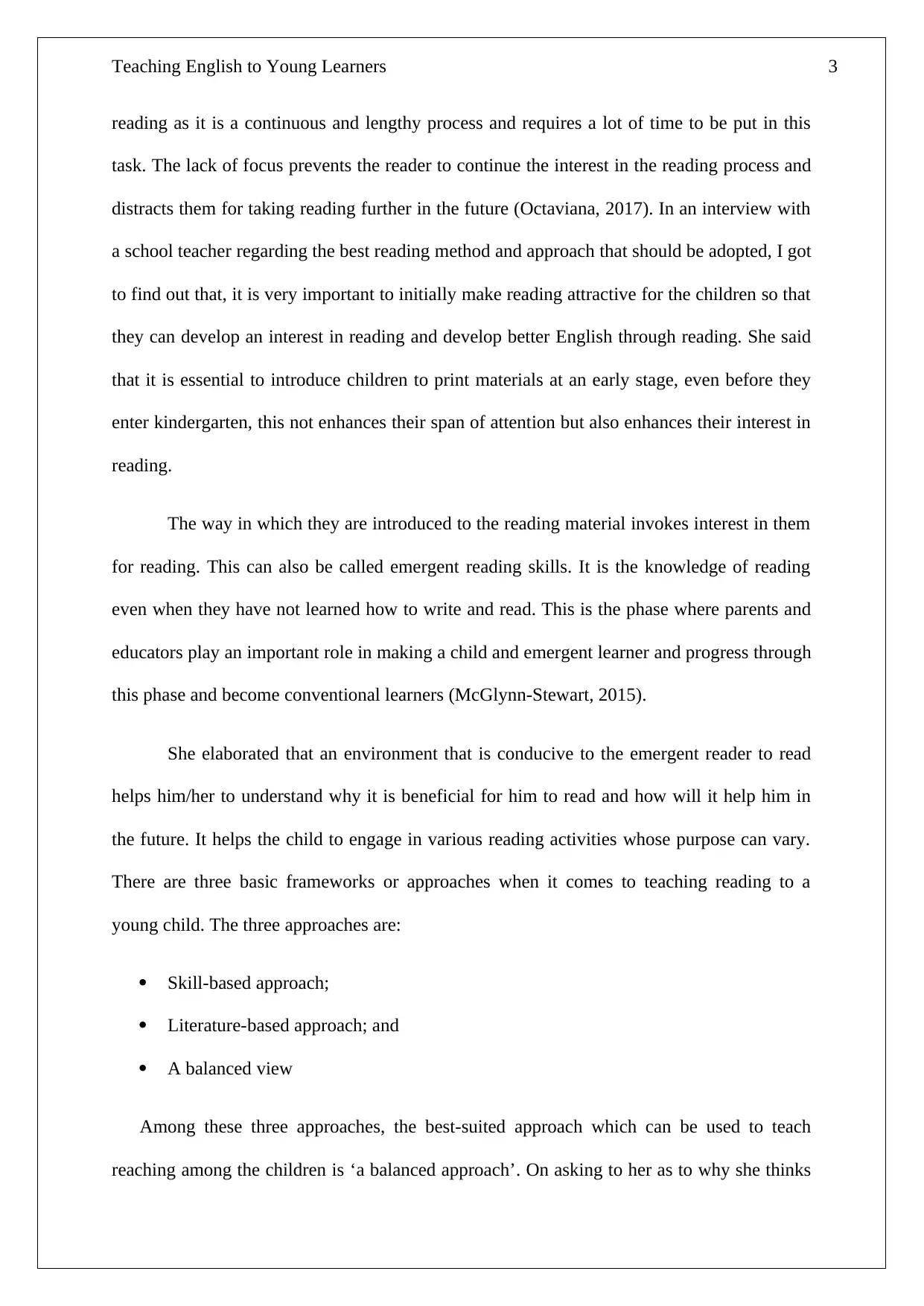
Teaching English to Young Learners 3
reading as it is a continuous and lengthy process and requires a lot of time to be put in this
task. The lack of focus prevents the reader to continue the interest in the reading process and
distracts them for taking reading further in the future (Octaviana, 2017). In an interview with
a school teacher regarding the best reading method and approach that should be adopted, I got
to find out that, it is very important to initially make reading attractive for the children so that
they can develop an interest in reading and develop better English through reading. She said
that it is essential to introduce children to print materials at an early stage, even before they
enter kindergarten, this not enhances their span of attention but also enhances their interest in
reading.
The way in which they are introduced to the reading material invokes interest in them
for reading. This can also be called emergent reading skills. It is the knowledge of reading
even when they have not learned how to write and read. This is the phase where parents and
educators play an important role in making a child and emergent learner and progress through
this phase and become conventional learners (McGlynn-Stewart, 2015).
She elaborated that an environment that is conducive to the emergent reader to read
helps him/her to understand why it is beneficial for him to read and how will it help him in
the future. It helps the child to engage in various reading activities whose purpose can vary.
There are three basic frameworks or approaches when it comes to teaching reading to a
young child. The three approaches are:
Skill-based approach;
Literature-based approach; and
A balanced view
Among these three approaches, the best-suited approach which can be used to teach
reaching among the children is ‘a balanced approach’. On asking to her as to why she thinks
reading as it is a continuous and lengthy process and requires a lot of time to be put in this
task. The lack of focus prevents the reader to continue the interest in the reading process and
distracts them for taking reading further in the future (Octaviana, 2017). In an interview with
a school teacher regarding the best reading method and approach that should be adopted, I got
to find out that, it is very important to initially make reading attractive for the children so that
they can develop an interest in reading and develop better English through reading. She said
that it is essential to introduce children to print materials at an early stage, even before they
enter kindergarten, this not enhances their span of attention but also enhances their interest in
reading.
The way in which they are introduced to the reading material invokes interest in them
for reading. This can also be called emergent reading skills. It is the knowledge of reading
even when they have not learned how to write and read. This is the phase where parents and
educators play an important role in making a child and emergent learner and progress through
this phase and become conventional learners (McGlynn-Stewart, 2015).
She elaborated that an environment that is conducive to the emergent reader to read
helps him/her to understand why it is beneficial for him to read and how will it help him in
the future. It helps the child to engage in various reading activities whose purpose can vary.
There are three basic frameworks or approaches when it comes to teaching reading to a
young child. The three approaches are:
Skill-based approach;
Literature-based approach; and
A balanced view
Among these three approaches, the best-suited approach which can be used to teach
reaching among the children is ‘a balanced approach’. On asking to her as to why she thinks
Paraphrase This Document
Need a fresh take? Get an instant paraphrase of this document with our AI Paraphraser
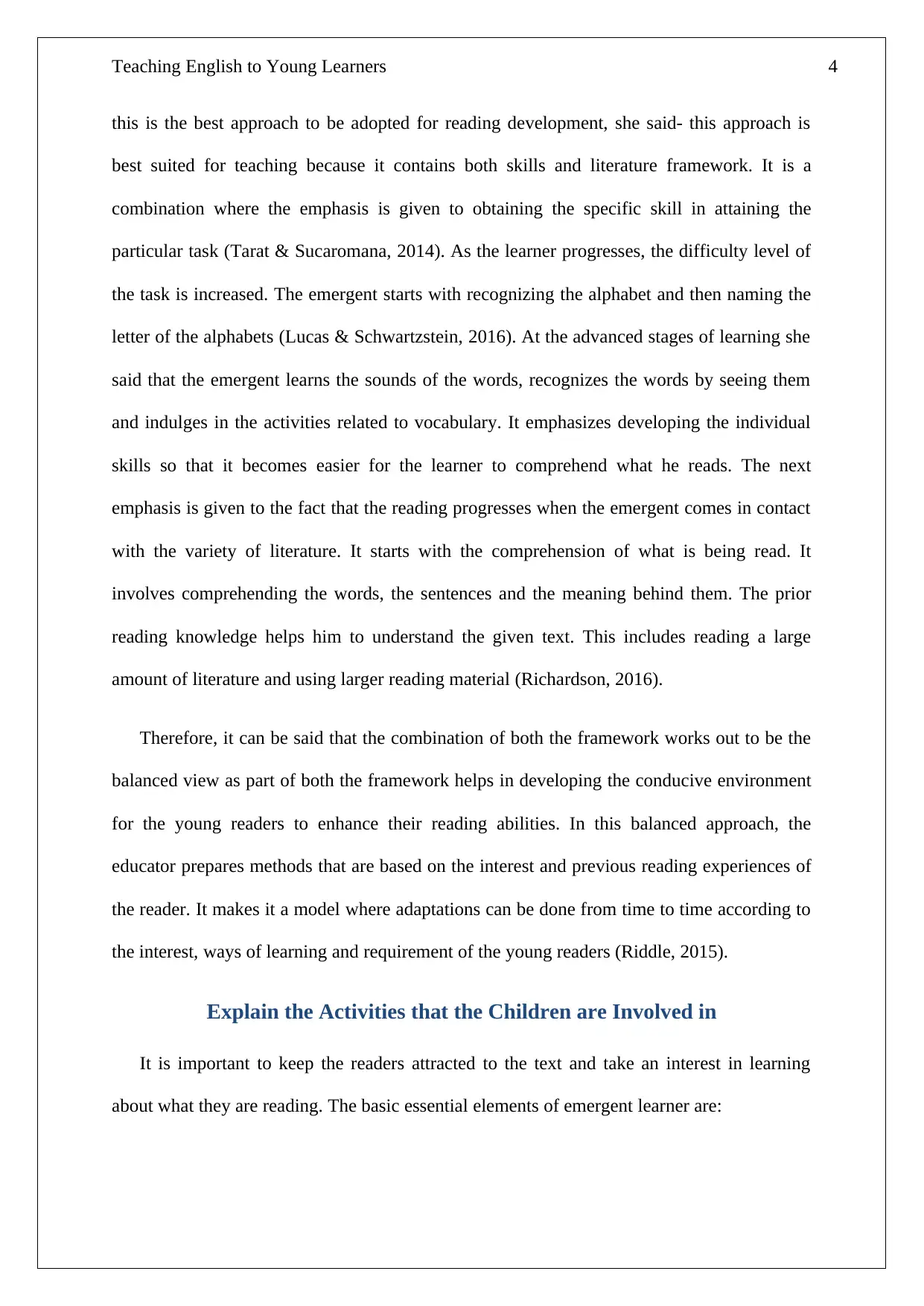
Teaching English to Young Learners 4
this is the best approach to be adopted for reading development, she said- this approach is
best suited for teaching because it contains both skills and literature framework. It is a
combination where the emphasis is given to obtaining the specific skill in attaining the
particular task (Tarat & Sucaromana, 2014). As the learner progresses, the difficulty level of
the task is increased. The emergent starts with recognizing the alphabet and then naming the
letter of the alphabets (Lucas & Schwartzstein, 2016). At the advanced stages of learning she
said that the emergent learns the sounds of the words, recognizes the words by seeing them
and indulges in the activities related to vocabulary. It emphasizes developing the individual
skills so that it becomes easier for the learner to comprehend what he reads. The next
emphasis is given to the fact that the reading progresses when the emergent comes in contact
with the variety of literature. It starts with the comprehension of what is being read. It
involves comprehending the words, the sentences and the meaning behind them. The prior
reading knowledge helps him to understand the given text. This includes reading a large
amount of literature and using larger reading material (Richardson, 2016).
Therefore, it can be said that the combination of both the framework works out to be the
balanced view as part of both the framework helps in developing the conducive environment
for the young readers to enhance their reading abilities. In this balanced approach, the
educator prepares methods that are based on the interest and previous reading experiences of
the reader. It makes it a model where adaptations can be done from time to time according to
the interest, ways of learning and requirement of the young readers (Riddle, 2015).
Explain the Activities that the Children are Involved in
It is important to keep the readers attracted to the text and take an interest in learning
about what they are reading. The basic essential elements of emergent learner are:
this is the best approach to be adopted for reading development, she said- this approach is
best suited for teaching because it contains both skills and literature framework. It is a
combination where the emphasis is given to obtaining the specific skill in attaining the
particular task (Tarat & Sucaromana, 2014). As the learner progresses, the difficulty level of
the task is increased. The emergent starts with recognizing the alphabet and then naming the
letter of the alphabets (Lucas & Schwartzstein, 2016). At the advanced stages of learning she
said that the emergent learns the sounds of the words, recognizes the words by seeing them
and indulges in the activities related to vocabulary. It emphasizes developing the individual
skills so that it becomes easier for the learner to comprehend what he reads. The next
emphasis is given to the fact that the reading progresses when the emergent comes in contact
with the variety of literature. It starts with the comprehension of what is being read. It
involves comprehending the words, the sentences and the meaning behind them. The prior
reading knowledge helps him to understand the given text. This includes reading a large
amount of literature and using larger reading material (Richardson, 2016).
Therefore, it can be said that the combination of both the framework works out to be the
balanced view as part of both the framework helps in developing the conducive environment
for the young readers to enhance their reading abilities. In this balanced approach, the
educator prepares methods that are based on the interest and previous reading experiences of
the reader. It makes it a model where adaptations can be done from time to time according to
the interest, ways of learning and requirement of the young readers (Riddle, 2015).
Explain the Activities that the Children are Involved in
It is important to keep the readers attracted to the text and take an interest in learning
about what they are reading. The basic essential elements of emergent learner are:
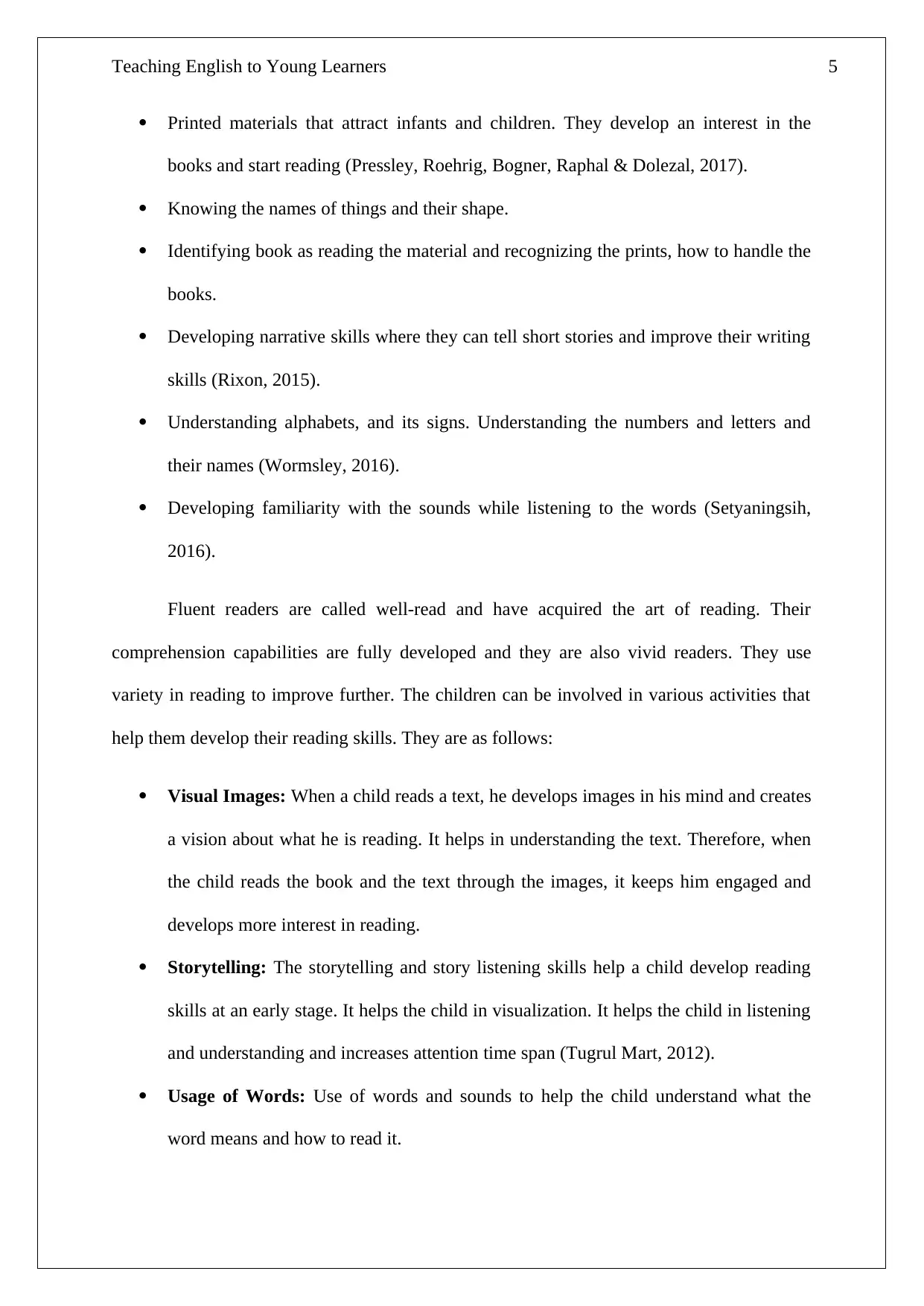
Teaching English to Young Learners 5
Printed materials that attract infants and children. They develop an interest in the
books and start reading (Pressley, Roehrig, Bogner, Raphal & Dolezal, 2017).
Knowing the names of things and their shape.
Identifying book as reading the material and recognizing the prints, how to handle the
books.
Developing narrative skills where they can tell short stories and improve their writing
skills (Rixon, 2015).
Understanding alphabets, and its signs. Understanding the numbers and letters and
their names (Wormsley, 2016).
Developing familiarity with the sounds while listening to the words (Setyaningsih,
2016).
Fluent readers are called well-read and have acquired the art of reading. Their
comprehension capabilities are fully developed and they are also vivid readers. They use
variety in reading to improve further. The children can be involved in various activities that
help them develop their reading skills. They are as follows:
Visual Images: When a child reads a text, he develops images in his mind and creates
a vision about what he is reading. It helps in understanding the text. Therefore, when
the child reads the book and the text through the images, it keeps him engaged and
develops more interest in reading.
Storytelling: The storytelling and story listening skills help a child develop reading
skills at an early stage. It helps the child in visualization. It helps the child in listening
and understanding and increases attention time span (Tugrul Mart, 2012).
Usage of Words: Use of words and sounds to help the child understand what the
word means and how to read it.
Printed materials that attract infants and children. They develop an interest in the
books and start reading (Pressley, Roehrig, Bogner, Raphal & Dolezal, 2017).
Knowing the names of things and their shape.
Identifying book as reading the material and recognizing the prints, how to handle the
books.
Developing narrative skills where they can tell short stories and improve their writing
skills (Rixon, 2015).
Understanding alphabets, and its signs. Understanding the numbers and letters and
their names (Wormsley, 2016).
Developing familiarity with the sounds while listening to the words (Setyaningsih,
2016).
Fluent readers are called well-read and have acquired the art of reading. Their
comprehension capabilities are fully developed and they are also vivid readers. They use
variety in reading to improve further. The children can be involved in various activities that
help them develop their reading skills. They are as follows:
Visual Images: When a child reads a text, he develops images in his mind and creates
a vision about what he is reading. It helps in understanding the text. Therefore, when
the child reads the book and the text through the images, it keeps him engaged and
develops more interest in reading.
Storytelling: The storytelling and story listening skills help a child develop reading
skills at an early stage. It helps the child in visualization. It helps the child in listening
and understanding and increases attention time span (Tugrul Mart, 2012).
Usage of Words: Use of words and sounds to help the child understand what the
word means and how to read it.
⊘ This is a preview!⊘
Do you want full access?
Subscribe today to unlock all pages.

Trusted by 1+ million students worldwide
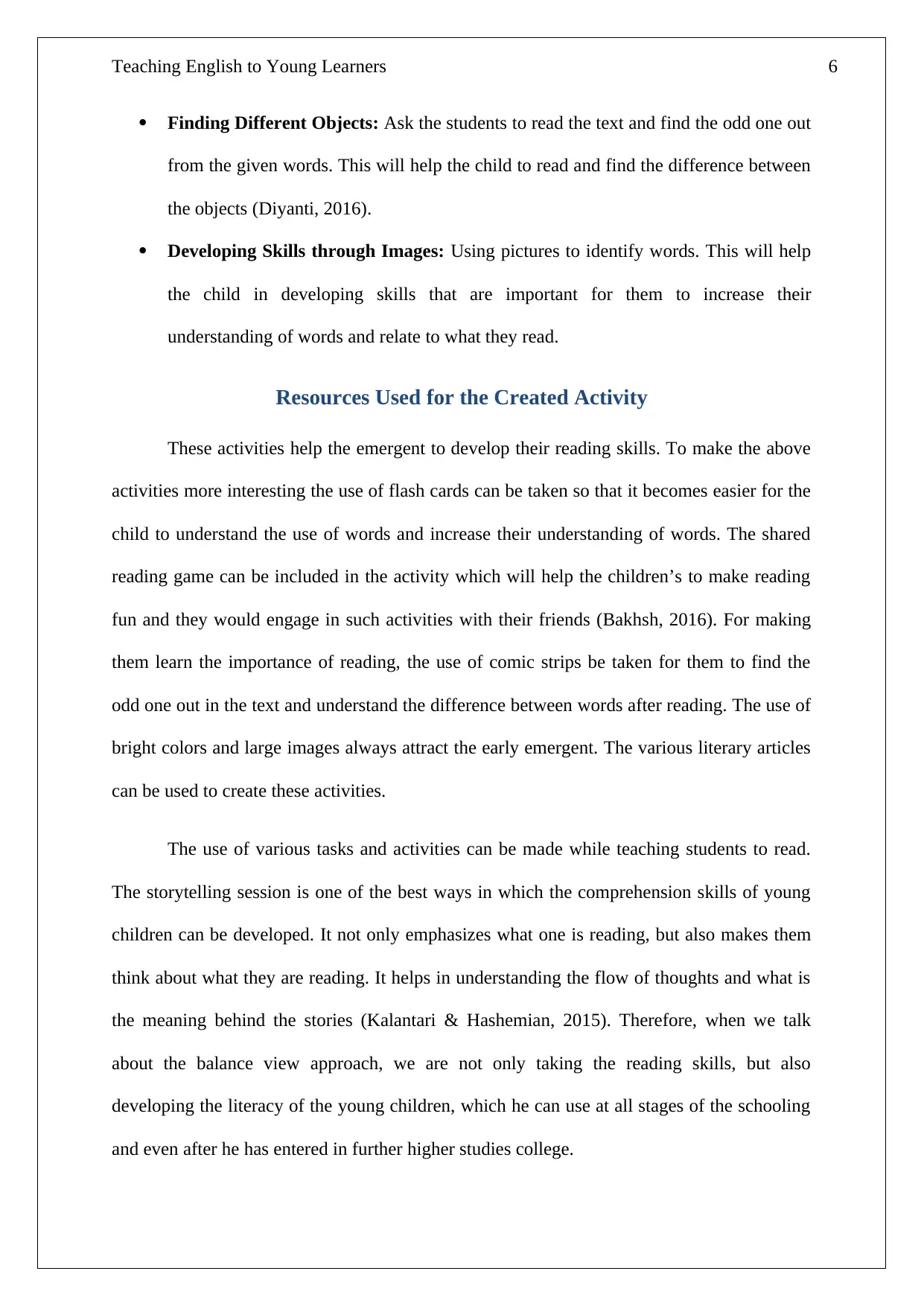
Teaching English to Young Learners 6
Finding Different Objects: Ask the students to read the text and find the odd one out
from the given words. This will help the child to read and find the difference between
the objects (Diyanti, 2016).
Developing Skills through Images: Using pictures to identify words. This will help
the child in developing skills that are important for them to increase their
understanding of words and relate to what they read.
Resources Used for the Created Activity
These activities help the emergent to develop their reading skills. To make the above
activities more interesting the use of flash cards can be taken so that it becomes easier for the
child to understand the use of words and increase their understanding of words. The shared
reading game can be included in the activity which will help the children’s to make reading
fun and they would engage in such activities with their friends (Bakhsh, 2016). For making
them learn the importance of reading, the use of comic strips be taken for them to find the
odd one out in the text and understand the difference between words after reading. The use of
bright colors and large images always attract the early emergent. The various literary articles
can be used to create these activities.
The use of various tasks and activities can be made while teaching students to read.
The storytelling session is one of the best ways in which the comprehension skills of young
children can be developed. It not only emphasizes what one is reading, but also makes them
think about what they are reading. It helps in understanding the flow of thoughts and what is
the meaning behind the stories (Kalantari & Hashemian, 2015). Therefore, when we talk
about the balance view approach, we are not only taking the reading skills, but also
developing the literacy of the young children, which he can use at all stages of the schooling
and even after he has entered in further higher studies college.
Finding Different Objects: Ask the students to read the text and find the odd one out
from the given words. This will help the child to read and find the difference between
the objects (Diyanti, 2016).
Developing Skills through Images: Using pictures to identify words. This will help
the child in developing skills that are important for them to increase their
understanding of words and relate to what they read.
Resources Used for the Created Activity
These activities help the emergent to develop their reading skills. To make the above
activities more interesting the use of flash cards can be taken so that it becomes easier for the
child to understand the use of words and increase their understanding of words. The shared
reading game can be included in the activity which will help the children’s to make reading
fun and they would engage in such activities with their friends (Bakhsh, 2016). For making
them learn the importance of reading, the use of comic strips be taken for them to find the
odd one out in the text and understand the difference between words after reading. The use of
bright colors and large images always attract the early emergent. The various literary articles
can be used to create these activities.
The use of various tasks and activities can be made while teaching students to read.
The storytelling session is one of the best ways in which the comprehension skills of young
children can be developed. It not only emphasizes what one is reading, but also makes them
think about what they are reading. It helps in understanding the flow of thoughts and what is
the meaning behind the stories (Kalantari & Hashemian, 2015). Therefore, when we talk
about the balance view approach, we are not only taking the reading skills, but also
developing the literacy of the young children, which he can use at all stages of the schooling
and even after he has entered in further higher studies college.
Paraphrase This Document
Need a fresh take? Get an instant paraphrase of this document with our AI Paraphraser
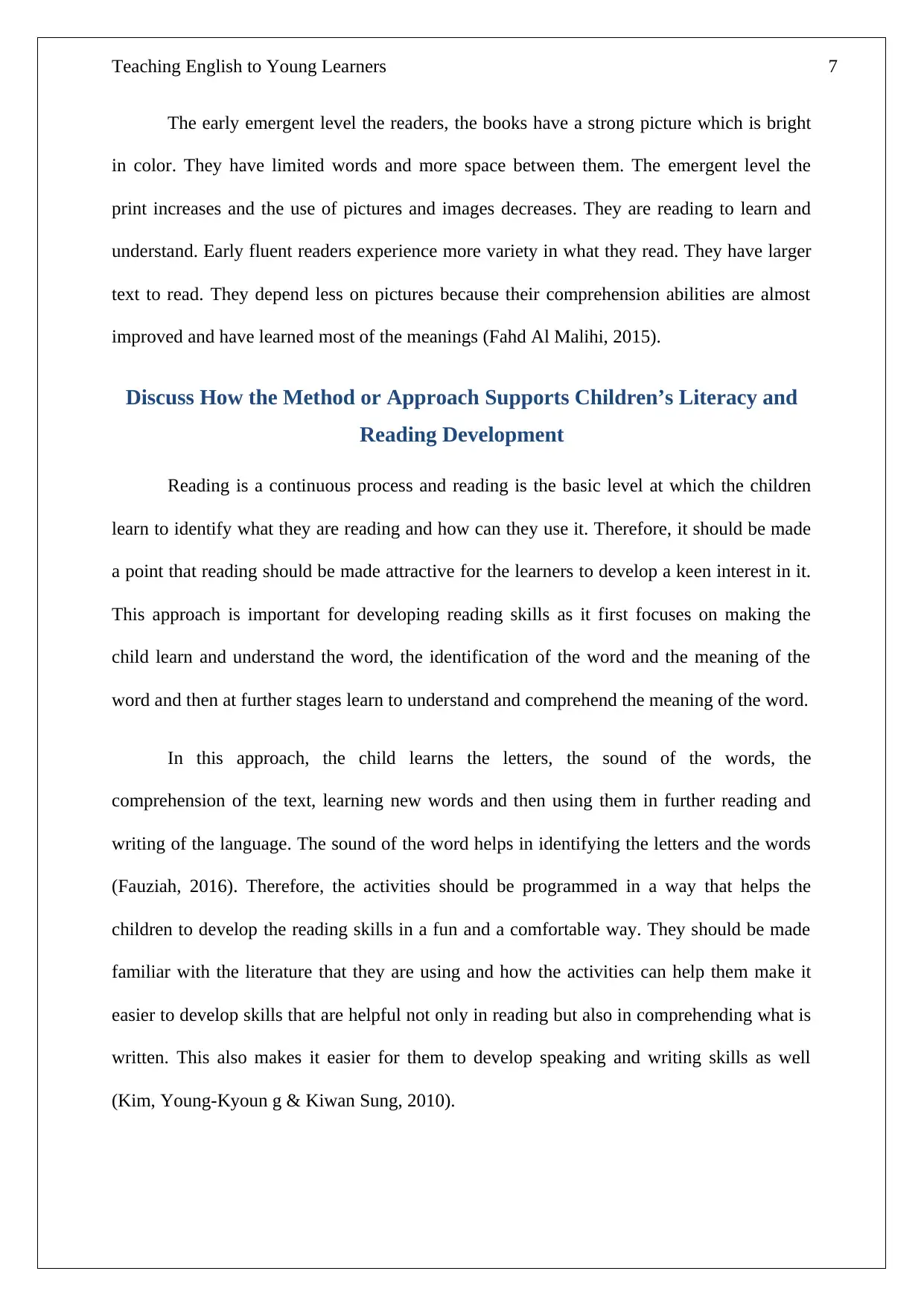
Teaching English to Young Learners 7
The early emergent level the readers, the books have a strong picture which is bright
in color. They have limited words and more space between them. The emergent level the
print increases and the use of pictures and images decreases. They are reading to learn and
understand. Early fluent readers experience more variety in what they read. They have larger
text to read. They depend less on pictures because their comprehension abilities are almost
improved and have learned most of the meanings (Fahd Al Malihi, 2015).
Discuss How the Method or Approach Supports Children’s Literacy and
Reading Development
Reading is a continuous process and reading is the basic level at which the children
learn to identify what they are reading and how can they use it. Therefore, it should be made
a point that reading should be made attractive for the learners to develop a keen interest in it.
This approach is important for developing reading skills as it first focuses on making the
child learn and understand the word, the identification of the word and the meaning of the
word and then at further stages learn to understand and comprehend the meaning of the word.
In this approach, the child learns the letters, the sound of the words, the
comprehension of the text, learning new words and then using them in further reading and
writing of the language. The sound of the word helps in identifying the letters and the words
(Fauziah, 2016). Therefore, the activities should be programmed in a way that helps the
children to develop the reading skills in a fun and a comfortable way. They should be made
familiar with the literature that they are using and how the activities can help them make it
easier to develop skills that are helpful not only in reading but also in comprehending what is
written. This also makes it easier for them to develop speaking and writing skills as well
(Kim, Young-Kyoun g & Kiwan Sung, 2010).
The early emergent level the readers, the books have a strong picture which is bright
in color. They have limited words and more space between them. The emergent level the
print increases and the use of pictures and images decreases. They are reading to learn and
understand. Early fluent readers experience more variety in what they read. They have larger
text to read. They depend less on pictures because their comprehension abilities are almost
improved and have learned most of the meanings (Fahd Al Malihi, 2015).
Discuss How the Method or Approach Supports Children’s Literacy and
Reading Development
Reading is a continuous process and reading is the basic level at which the children
learn to identify what they are reading and how can they use it. Therefore, it should be made
a point that reading should be made attractive for the learners to develop a keen interest in it.
This approach is important for developing reading skills as it first focuses on making the
child learn and understand the word, the identification of the word and the meaning of the
word and then at further stages learn to understand and comprehend the meaning of the word.
In this approach, the child learns the letters, the sound of the words, the
comprehension of the text, learning new words and then using them in further reading and
writing of the language. The sound of the word helps in identifying the letters and the words
(Fauziah, 2016). Therefore, the activities should be programmed in a way that helps the
children to develop the reading skills in a fun and a comfortable way. They should be made
familiar with the literature that they are using and how the activities can help them make it
easier to develop skills that are helpful not only in reading but also in comprehending what is
written. This also makes it easier for them to develop speaking and writing skills as well
(Kim, Young-Kyoun g & Kiwan Sung, 2010).
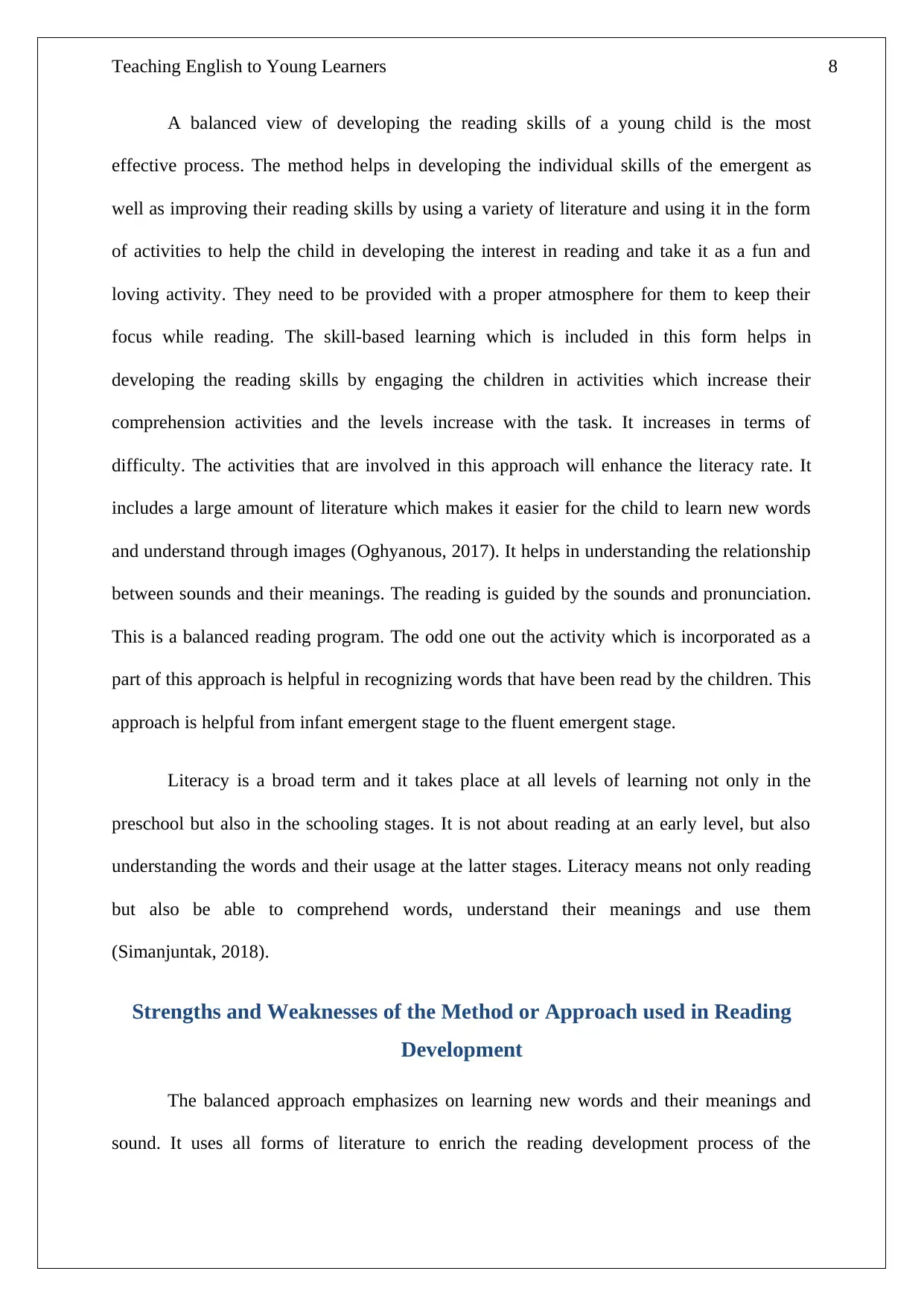
Teaching English to Young Learners 8
A balanced view of developing the reading skills of a young child is the most
effective process. The method helps in developing the individual skills of the emergent as
well as improving their reading skills by using a variety of literature and using it in the form
of activities to help the child in developing the interest in reading and take it as a fun and
loving activity. They need to be provided with a proper atmosphere for them to keep their
focus while reading. The skill-based learning which is included in this form helps in
developing the reading skills by engaging the children in activities which increase their
comprehension activities and the levels increase with the task. It increases in terms of
difficulty. The activities that are involved in this approach will enhance the literacy rate. It
includes a large amount of literature which makes it easier for the child to learn new words
and understand through images (Oghyanous, 2017). It helps in understanding the relationship
between sounds and their meanings. The reading is guided by the sounds and pronunciation.
This is a balanced reading program. The odd one out the activity which is incorporated as a
part of this approach is helpful in recognizing words that have been read by the children. This
approach is helpful from infant emergent stage to the fluent emergent stage.
Literacy is a broad term and it takes place at all levels of learning not only in the
preschool but also in the schooling stages. It is not about reading at an early level, but also
understanding the words and their usage at the latter stages. Literacy means not only reading
but also be able to comprehend words, understand their meanings and use them
(Simanjuntak, 2018).
Strengths and Weaknesses of the Method or Approach used in Reading
Development
The balanced approach emphasizes on learning new words and their meanings and
sound. It uses all forms of literature to enrich the reading development process of the
A balanced view of developing the reading skills of a young child is the most
effective process. The method helps in developing the individual skills of the emergent as
well as improving their reading skills by using a variety of literature and using it in the form
of activities to help the child in developing the interest in reading and take it as a fun and
loving activity. They need to be provided with a proper atmosphere for them to keep their
focus while reading. The skill-based learning which is included in this form helps in
developing the reading skills by engaging the children in activities which increase their
comprehension activities and the levels increase with the task. It increases in terms of
difficulty. The activities that are involved in this approach will enhance the literacy rate. It
includes a large amount of literature which makes it easier for the child to learn new words
and understand through images (Oghyanous, 2017). It helps in understanding the relationship
between sounds and their meanings. The reading is guided by the sounds and pronunciation.
This is a balanced reading program. The odd one out the activity which is incorporated as a
part of this approach is helpful in recognizing words that have been read by the children. This
approach is helpful from infant emergent stage to the fluent emergent stage.
Literacy is a broad term and it takes place at all levels of learning not only in the
preschool but also in the schooling stages. It is not about reading at an early level, but also
understanding the words and their usage at the latter stages. Literacy means not only reading
but also be able to comprehend words, understand their meanings and use them
(Simanjuntak, 2018).
Strengths and Weaknesses of the Method or Approach used in Reading
Development
The balanced approach emphasizes on learning new words and their meanings and
sound. It uses all forms of literature to enrich the reading development process of the
⊘ This is a preview!⊘
Do you want full access?
Subscribe today to unlock all pages.

Trusted by 1+ million students worldwide
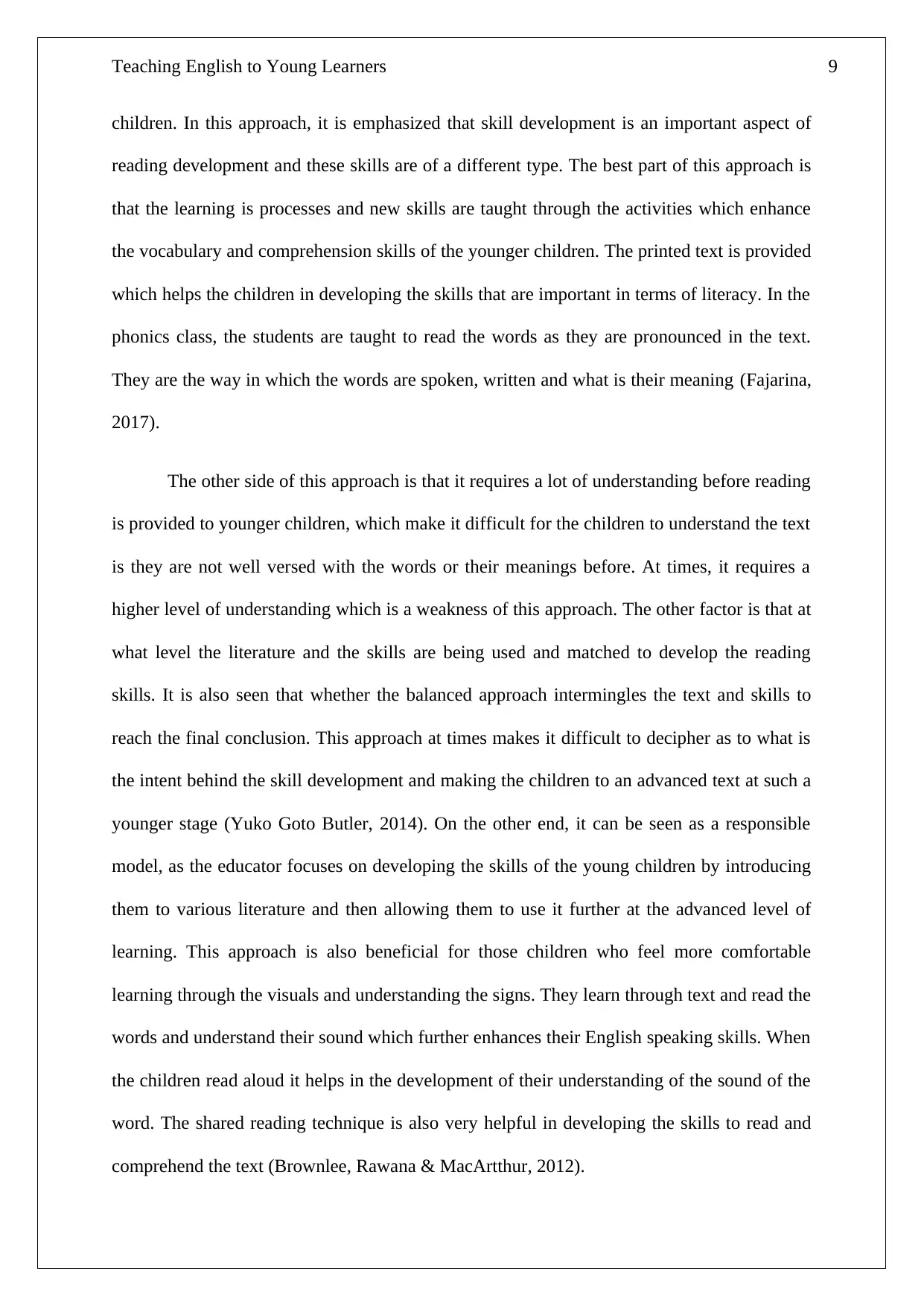
Teaching English to Young Learners 9
children. In this approach, it is emphasized that skill development is an important aspect of
reading development and these skills are of a different type. The best part of this approach is
that the learning is processes and new skills are taught through the activities which enhance
the vocabulary and comprehension skills of the younger children. The printed text is provided
which helps the children in developing the skills that are important in terms of literacy. In the
phonics class, the students are taught to read the words as they are pronounced in the text.
They are the way in which the words are spoken, written and what is their meaning (Fajarina,
2017).
The other side of this approach is that it requires a lot of understanding before reading
is provided to younger children, which make it difficult for the children to understand the text
is they are not well versed with the words or their meanings before. At times, it requires a
higher level of understanding which is a weakness of this approach. The other factor is that at
what level the literature and the skills are being used and matched to develop the reading
skills. It is also seen that whether the balanced approach intermingles the text and skills to
reach the final conclusion. This approach at times makes it difficult to decipher as to what is
the intent behind the skill development and making the children to an advanced text at such a
younger stage (Yuko Goto Butler, 2014). On the other end, it can be seen as a responsible
model, as the educator focuses on developing the skills of the young children by introducing
them to various literature and then allowing them to use it further at the advanced level of
learning. This approach is also beneficial for those children who feel more comfortable
learning through the visuals and understanding the signs. They learn through text and read the
words and understand their sound which further enhances their English speaking skills. When
the children read aloud it helps in the development of their understanding of the sound of the
word. The shared reading technique is also very helpful in developing the skills to read and
comprehend the text (Brownlee, Rawana & MacArtthur, 2012).
children. In this approach, it is emphasized that skill development is an important aspect of
reading development and these skills are of a different type. The best part of this approach is
that the learning is processes and new skills are taught through the activities which enhance
the vocabulary and comprehension skills of the younger children. The printed text is provided
which helps the children in developing the skills that are important in terms of literacy. In the
phonics class, the students are taught to read the words as they are pronounced in the text.
They are the way in which the words are spoken, written and what is their meaning (Fajarina,
2017).
The other side of this approach is that it requires a lot of understanding before reading
is provided to younger children, which make it difficult for the children to understand the text
is they are not well versed with the words or their meanings before. At times, it requires a
higher level of understanding which is a weakness of this approach. The other factor is that at
what level the literature and the skills are being used and matched to develop the reading
skills. It is also seen that whether the balanced approach intermingles the text and skills to
reach the final conclusion. This approach at times makes it difficult to decipher as to what is
the intent behind the skill development and making the children to an advanced text at such a
younger stage (Yuko Goto Butler, 2014). On the other end, it can be seen as a responsible
model, as the educator focuses on developing the skills of the young children by introducing
them to various literature and then allowing them to use it further at the advanced level of
learning. This approach is also beneficial for those children who feel more comfortable
learning through the visuals and understanding the signs. They learn through text and read the
words and understand their sound which further enhances their English speaking skills. When
the children read aloud it helps in the development of their understanding of the sound of the
word. The shared reading technique is also very helpful in developing the skills to read and
comprehend the text (Brownlee, Rawana & MacArtthur, 2012).
Paraphrase This Document
Need a fresh take? Get an instant paraphrase of this document with our AI Paraphraser
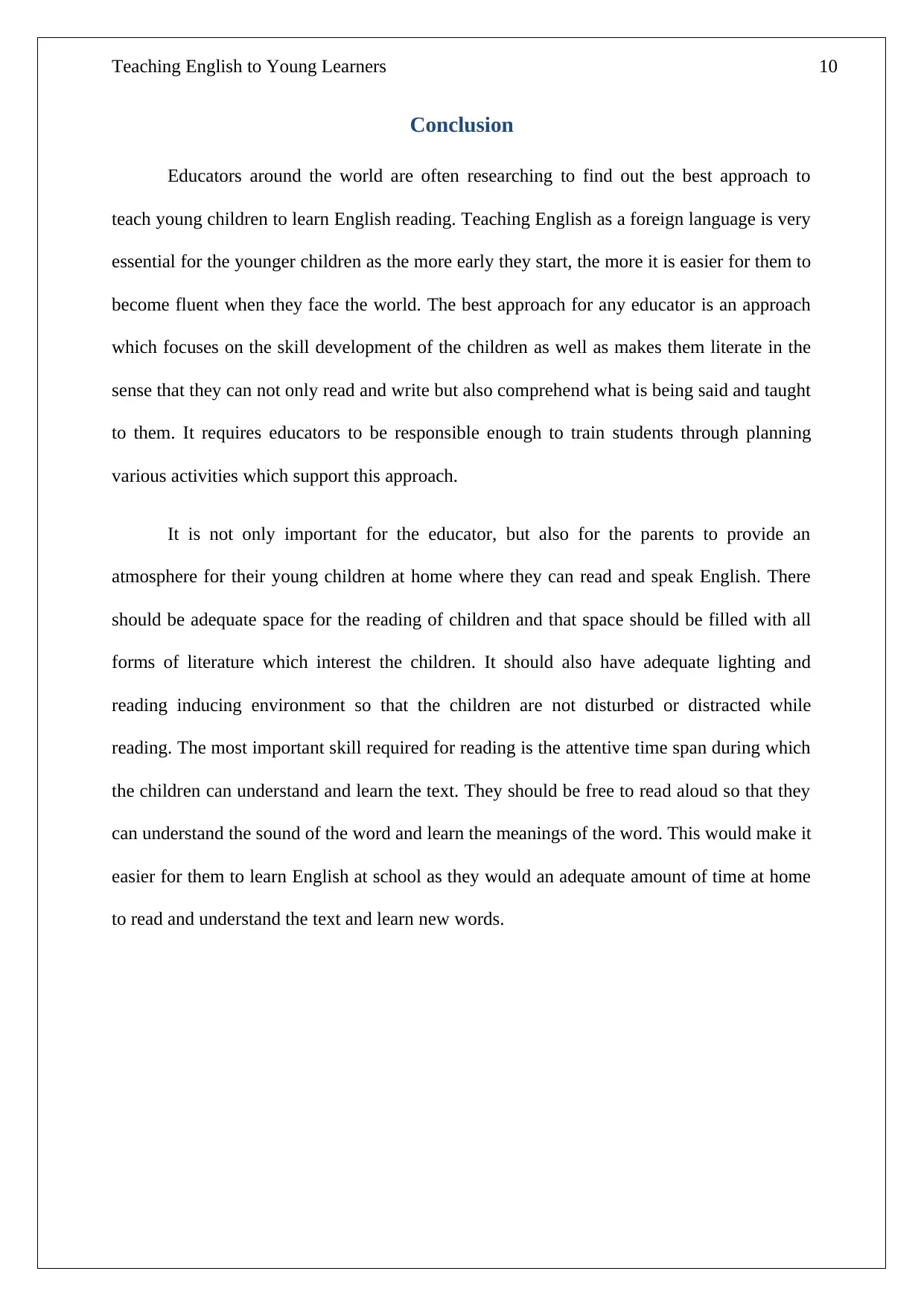
Teaching English to Young Learners 10
Conclusion
Educators around the world are often researching to find out the best approach to
teach young children to learn English reading. Teaching English as a foreign language is very
essential for the younger children as the more early they start, the more it is easier for them to
become fluent when they face the world. The best approach for any educator is an approach
which focuses on the skill development of the children as well as makes them literate in the
sense that they can not only read and write but also comprehend what is being said and taught
to them. It requires educators to be responsible enough to train students through planning
various activities which support this approach.
It is not only important for the educator, but also for the parents to provide an
atmosphere for their young children at home where they can read and speak English. There
should be adequate space for the reading of children and that space should be filled with all
forms of literature which interest the children. It should also have adequate lighting and
reading inducing environment so that the children are not disturbed or distracted while
reading. The most important skill required for reading is the attentive time span during which
the children can understand and learn the text. They should be free to read aloud so that they
can understand the sound of the word and learn the meanings of the word. This would make it
easier for them to learn English at school as they would an adequate amount of time at home
to read and understand the text and learn new words.
Conclusion
Educators around the world are often researching to find out the best approach to
teach young children to learn English reading. Teaching English as a foreign language is very
essential for the younger children as the more early they start, the more it is easier for them to
become fluent when they face the world. The best approach for any educator is an approach
which focuses on the skill development of the children as well as makes them literate in the
sense that they can not only read and write but also comprehend what is being said and taught
to them. It requires educators to be responsible enough to train students through planning
various activities which support this approach.
It is not only important for the educator, but also for the parents to provide an
atmosphere for their young children at home where they can read and speak English. There
should be adequate space for the reading of children and that space should be filled with all
forms of literature which interest the children. It should also have adequate lighting and
reading inducing environment so that the children are not disturbed or distracted while
reading. The most important skill required for reading is the attentive time span during which
the children can understand and learn the text. They should be free to read aloud so that they
can understand the sound of the word and learn the meanings of the word. This would make it
easier for them to learn English at school as they would an adequate amount of time at home
to read and understand the text and learn new words.
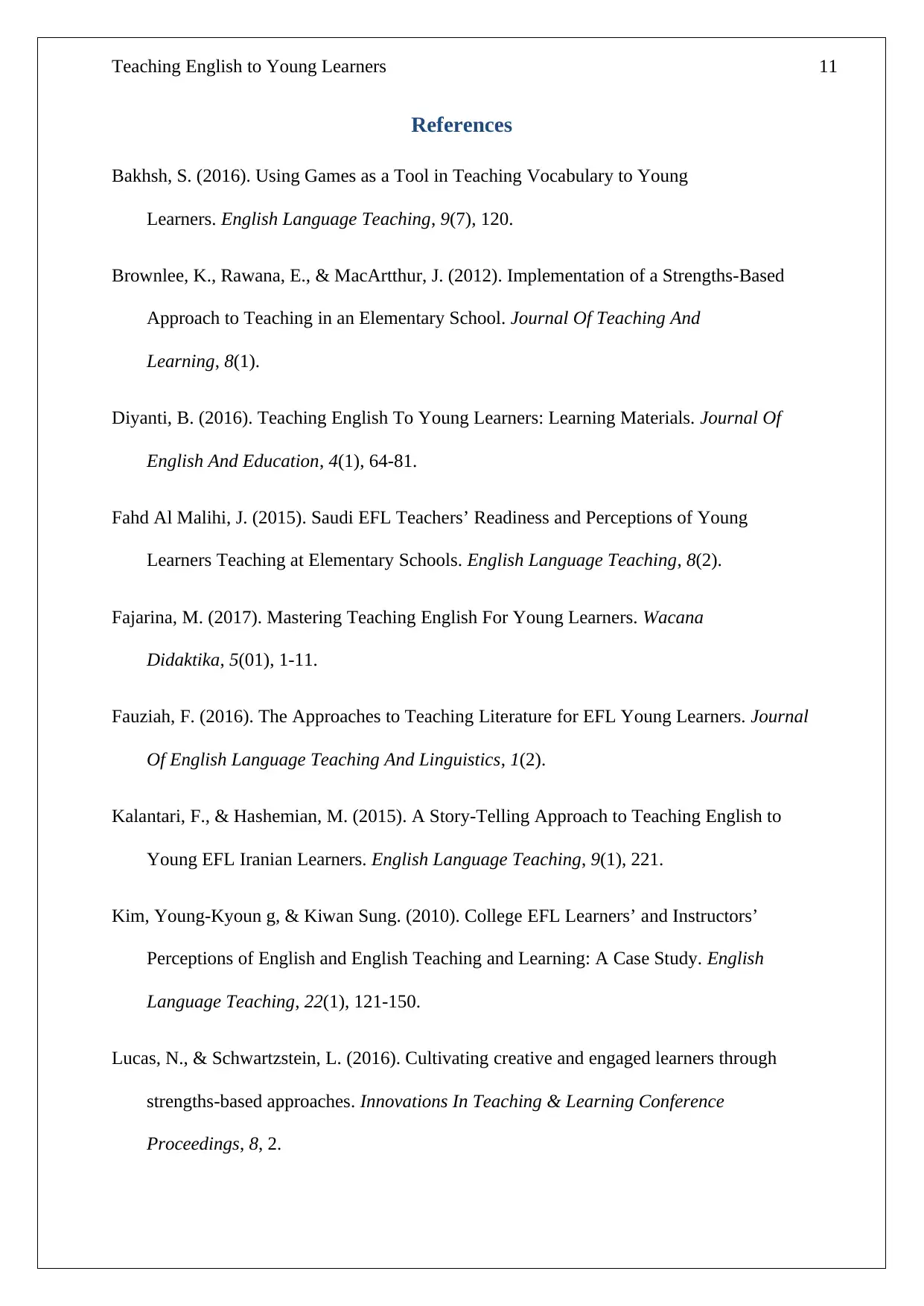
Teaching English to Young Learners 11
References
Bakhsh, S. (2016). Using Games as a Tool in Teaching Vocabulary to Young
Learners. English Language Teaching, 9(7), 120.
Brownlee, K., Rawana, E., & MacArtthur, J. (2012). Implementation of a Strengths-Based
Approach to Teaching in an Elementary School. Journal Of Teaching And
Learning, 8(1).
Diyanti, B. (2016). Teaching English To Young Learners: Learning Materials. Journal Of
English And Education, 4(1), 64-81.
Fahd Al Malihi, J. (2015). Saudi EFL Teachers’ Readiness and Perceptions of Young
Learners Teaching at Elementary Schools. English Language Teaching, 8(2).
Fajarina, M. (2017). Mastering Teaching English For Young Learners. Wacana
Didaktika, 5(01), 1-11.
Fauziah, F. (2016). The Approaches to Teaching Literature for EFL Young Learners. Journal
Of English Language Teaching And Linguistics, 1(2).
Kalantari, F., & Hashemian, M. (2015). A Story-Telling Approach to Teaching English to
Young EFL Iranian Learners. English Language Teaching, 9(1), 221.
Kim, Young-Kyoun g, & Kiwan Sung. (2010). College EFL Learners’ and Instructors’
Perceptions of English and English Teaching and Learning: A Case Study. English
Language Teaching, 22(1), 121-150.
Lucas, N., & Schwartzstein, L. (2016). Cultivating creative and engaged learners through
strengths-based approaches. Innovations In Teaching & Learning Conference
Proceedings, 8, 2.
References
Bakhsh, S. (2016). Using Games as a Tool in Teaching Vocabulary to Young
Learners. English Language Teaching, 9(7), 120.
Brownlee, K., Rawana, E., & MacArtthur, J. (2012). Implementation of a Strengths-Based
Approach to Teaching in an Elementary School. Journal Of Teaching And
Learning, 8(1).
Diyanti, B. (2016). Teaching English To Young Learners: Learning Materials. Journal Of
English And Education, 4(1), 64-81.
Fahd Al Malihi, J. (2015). Saudi EFL Teachers’ Readiness and Perceptions of Young
Learners Teaching at Elementary Schools. English Language Teaching, 8(2).
Fajarina, M. (2017). Mastering Teaching English For Young Learners. Wacana
Didaktika, 5(01), 1-11.
Fauziah, F. (2016). The Approaches to Teaching Literature for EFL Young Learners. Journal
Of English Language Teaching And Linguistics, 1(2).
Kalantari, F., & Hashemian, M. (2015). A Story-Telling Approach to Teaching English to
Young EFL Iranian Learners. English Language Teaching, 9(1), 221.
Kim, Young-Kyoun g, & Kiwan Sung. (2010). College EFL Learners’ and Instructors’
Perceptions of English and English Teaching and Learning: A Case Study. English
Language Teaching, 22(1), 121-150.
Lucas, N., & Schwartzstein, L. (2016). Cultivating creative and engaged learners through
strengths-based approaches. Innovations In Teaching & Learning Conference
Proceedings, 8, 2.
⊘ This is a preview!⊘
Do you want full access?
Subscribe today to unlock all pages.

Trusted by 1+ million students worldwide
1 out of 14
Related Documents
Your All-in-One AI-Powered Toolkit for Academic Success.
+13062052269
info@desklib.com
Available 24*7 on WhatsApp / Email
![[object Object]](/_next/static/media/star-bottom.7253800d.svg)
Unlock your academic potential
Copyright © 2020–2025 A2Z Services. All Rights Reserved. Developed and managed by ZUCOL.





